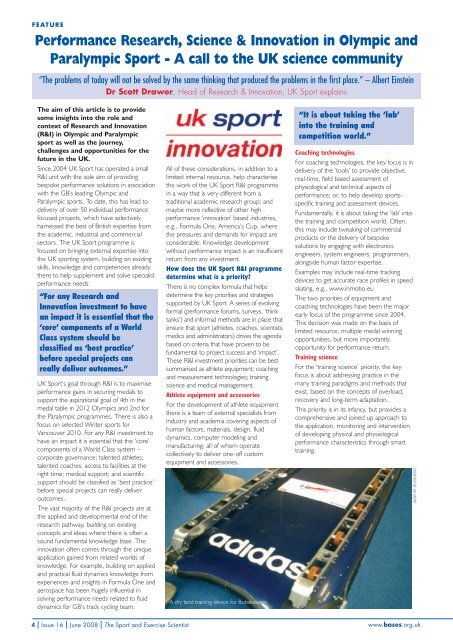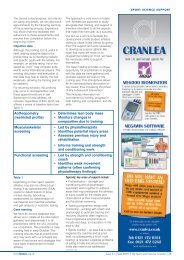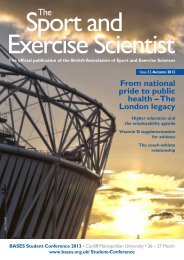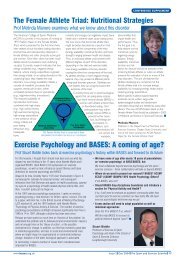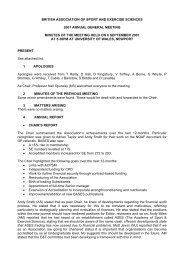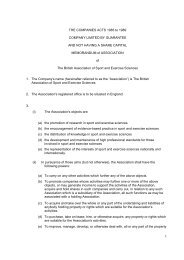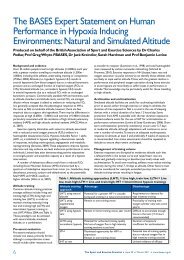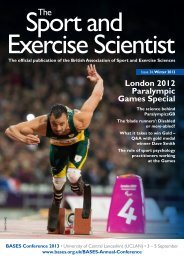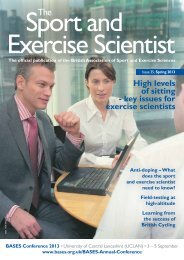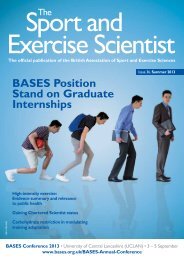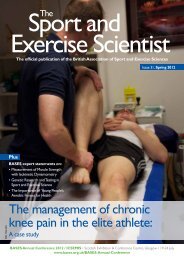Part 1 - Bases
Part 1 - Bases
Part 1 - Bases
- No tags were found...
You also want an ePaper? Increase the reach of your titles
YUMPU automatically turns print PDFs into web optimized ePapers that Google loves.
COURTESY OF UK SPORTFEATUREPerformance Research, Science & Innovation in Olympic andParalympic Sport - A call to the UK science community“The problems of today will not be solved by the same thinking that produced the problems in the first place.” – Albert EinsteinDr Scott Drawer, Head of Research & Innovation, UK Sport explainsThe aim of this article is to providesome insights into the role andcontext of Research and Innovation(R&I) in Olympic and Paralympicsport as well as the journey,challenges and opportunities for thefuture in the UK.Since 2004 UK Sport has operated a smallR&I unit with the sole aim of providingbespoke performance solutions in associationwith the GB’s leading Olympic andParalympic sports. To date, this has lead todelivery of over 50 individual performancefocused projects, which have selectivelyharnessed the best of British expertise fromthe academic, industrial and commercialsectors. The UK Sport programme isfocused on bringing external expertise intothe UK sporting system, building on existingskills, knowledge and competencies alreadythere to help supplement and solve specialistperformance needs.“For any Research andInnovation investment to havean impact it is essential that the‘core’ components of a WorldClass system should beclassified as ‘best practice’before special projects canreally deliver outcomes.”UK Sport’s goal through R&I is to maximiseperformance gains in securing medals tosupport the aspirational goal of 4th in themedal table in 2012 Olympics and 2nd forthe Paralympic programmes. There is also afocus on selected Winter sports forVancouver 2010. For any R&I investment tohave an impact it is essential that the ‘core’components of a World Class system –corporate governance; talented athletes;talented coaches; access to facilities at theright time; medical support; and scientificsupport should be classified as ‘best practice’before special projects can really deliveroutcomes.The vast majority of the R&I projects are atthe applied and developmental end of theresearch pathway, building on existingconcepts and ideas where there is often asound fundamental knowledge base. Theinnovation often comes through the uniqueapplication gained from related worlds ofknowledge. For example, building on appliedand practical fluid dynamics knowledge fromexperiences and insights in Formula One andaerospace has been hugely influential insolving performance needs related to fluiddynamics for GB’s track cycling team.All of these considerations, in addition to alimited internal resource, help characterisethe work of the UK Sport R&I programmein a way that is very different from atraditional academic research group; andmaybe more reflective of other highperformance ‘innovation’ based industries,e.g., Formula One, America’s Cup, wherethe pressures and demands for impact areconsiderable. Knowledge developmentwithout performance impact is an insufficientreturn from any investment.How does the UK Sport R&I programmedetermine what is a priority?There is no complex formula that helpsdetermine the key priorities and strategiessupported by UK Sport. A series of evolvingformal (performance forums, surveys, ‘thinktanks’) and informal methods are in place thatensure that sport (athletes, coaches, scientists,medics and administrators) drives the agendabased on criteria that have proven to befundamental to project success and ‘impact’.These R&I investment priorities can be bestsummarised as athlete equipment; coachingand measurement technologies; trainingscience and medical management.Athlete equipment and accessoriesFor the development of athlete equipmentthere is a team of external specialists fromindustry and academia covering aspects ofhuman factors, materials, design, fluiddynamics, computer modeling andmanufacturing; all of whom operatecollectively to deliver one-off customequipment and accessories.A dry land training device for Bobskeleton“It is about taking the ‘lab’into the training andcompetition world.”Coaching technologiesFor coaching technologies, the key focus is indelivery of the ‘tools’ to provide objective,real-time, field based assessment ofphysiological and technical aspects ofperformance; or, to help develop sportsspecifictraining and assessment devices.Fundamentally, it is about taking the ‘lab’ intothe training and competition world. Often,this may include tweaking of commercialproducts or the delivery of bespokesolutions by engaging with electronicsengineers, system engineers, programmers,alongside human factor expertise.Examples may include real-time trackingdevices to get accurate race profiles in speedskating, e.g., www.inmotio.euThe two priorities of equipment andcoaching technologies have been the majorearly focus of the programme since 2004.This decision was made on the basis oflimited resource, multiple medal winningopportunities, but more importantly,opportunity for performance return.Training scienceFor the ‘training science’ priority, the keyfocus is about addressing practice in themany training paradigms and methods thatexist, based on the concepts of overload,recovery and long-term adaptation.This priority is in its infancy, but provides acomprehensive and joined up approach tothe application, monitoring and interventionof developing physical and physiologicalperformance characteristics through smarttraining.4 l Issue 16 l June 2008 l The Sport and Exercise Scientistwww.bases.org.uk


